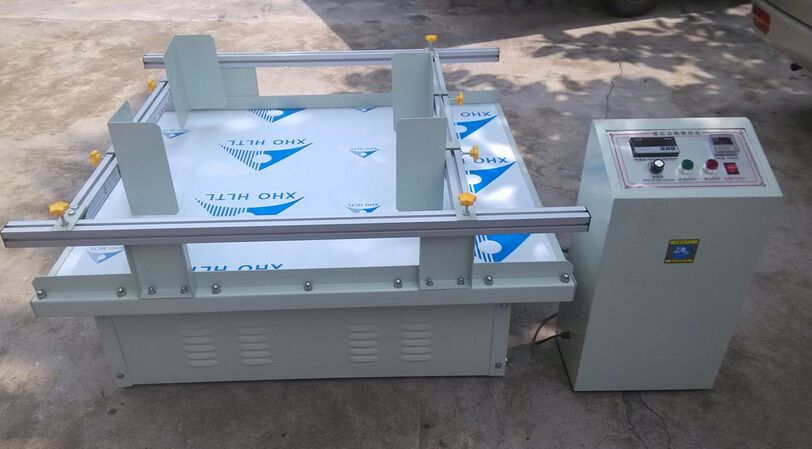ISO 13355-9 Vehicle Simulation Vibration Test
The ISO 13355-9 standard is designed to evaluate the durability and performance of packaging under vibration conditions that simulate vehicle transport. This test is crucial for ensuring that packages can withstand the harsh environments encountered during shipment, thereby protecting the integrity of the contents.
Vibration testing is a critical aspect of quality assurance in logistics and manufacturing industries. It helps identify potential design flaws early on, preventing costly damage to products and maintaining customer satisfaction. The ISO 13355-9 standard provides specific guidelines for simulating road conditions, including various types of roads and driving styles.
The test setup typically involves placing the package on a shaker system that replicates the vibrations experienced during transportation. The frequency range used in this test is from 0.2 Hz to 80 Hz, which covers most of the typical vehicle vibration frequencies encountered during transport. This comprehensive approach ensures that any potential issues are identified before the product reaches the consumer.
During testing, the package undergoes both sine and random vibration tests. Sine wave testing is used to evaluate the package's response at specific frequencies, while random vibration simulates real-world conditions more accurately by providing a broad frequency spectrum of vibrations. These tests help in determining how well the packaging can handle various stresses without compromising its protective capabilities.
The ISO 13355-9 standard also emphasizes the importance of preconditioning packages before testing to ensure accurate results. This includes ensuring that the package is at a stable temperature and humidity level, as these factors significantly influence the package's performance during vibration. After the test, visual inspections are conducted to identify any signs of damage or deformation.
For more detailed information on the specific parameters involved in this testing procedure, refer to ISO 13355-9:2020, which provides a comprehensive breakdown of all aspects related to vehicle simulation vibration tests. Compliance with these standards is essential for manufacturers and logistics providers who wish to ensure their products meet international quality and safety requirements.
Why Choose This Test
The ISO 13355-9 Vehicle Simulation Vibration Test offers several advantages that make it a preferred choice for manufacturers and logistics companies. Firstly, it provides a realistic simulation of the conditions packages face during transportation, enabling engineers to identify potential weaknesses early in the design process.
Secondly, this test ensures compliance with international standards, which is increasingly important as global supply chains become more integrated. By adhering to these standards, companies can demonstrate their commitment to quality and reliability, thereby enhancing their reputation and market position.
The third advantage lies in the early detection of issues that could lead to costly repairs or replacements downstream. Early identification allows for necessary adjustments to be made promptly, saving time and resources in the long run. Moreover, this test helps maintain consistent product quality across different transportation modes and geographical locations.
Lastly, ISO 13355-9 is widely recognized and accepted by regulatory bodies worldwide. This broad acceptance ensures that the results of these tests are credible and can be used to make informed decisions about packaging design and manufacturing processes.
International Acceptance and Recognition
The ISO 13355-9 standard has gained significant traction in the international community, being adopted by numerous countries as a benchmark for vehicle simulation vibration testing. Its widespread acceptance is due to its rigorous methodology and emphasis on real-world applicability.
Many organizations have incorporated this standard into their quality management systems (QMS) and product development processes. For instance, major automotive manufacturers often use ISO 13355-9 as part of their supplier evaluation process to ensure that the packaging they provide meets stringent requirements for durability and protection.
Regulatory bodies around the world also recognize the importance of this standard, making it mandatory in some cases. For example, certain industries may require compliance with ISO 13355-9 as part of their safety regulations or environmental impact assessments. This recognition underscores its relevance and reliability in ensuring product integrity during transportation.
In conclusion, choosing the ISO 13355-9 Vehicle Simulation Vibration Test not only enhances your product's performance but also supports broader goals like sustainability and global competitiveness. By adhering to this standard, you contribute to a more efficient and reliable supply chain while maintaining high standards of quality.
Use Cases and Application Examples
| Industry Sector | Application Example | Test Parameters |
|---|---|---|
| Automotive Manufacturing | Evaluating the durability of packaging used for components during shipment. | Vibration frequencies from 0.2 Hz to 80 Hz, sine wave and random vibration testing. |
| Electronics Manufacturing | Ensuring that electronic devices within the package are protected against vibrations during transport. | Same as above with additional focus on temperature and humidity conditions. |
| Pharmaceutical Industry | Testing packaging used for transporting sensitive medications to ensure they remain stable under vibration. | Incorporating time-temperature stability criteria into the test parameters. |





